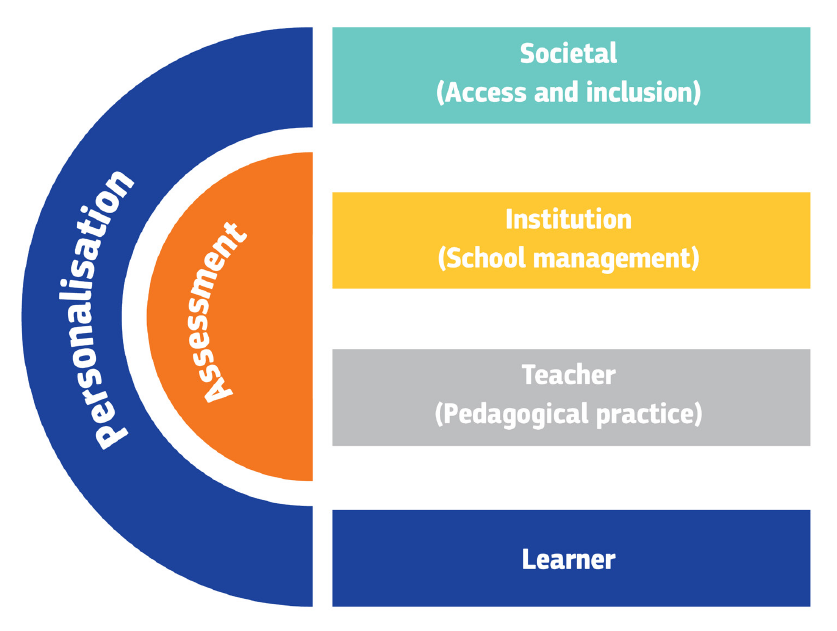EDEH Squad “AI in Education” learning journey
Nowadays, we are overwhelmed with news about artificial intelligence, its impact on our work and daily lives, and its potential benefits and threats. What impact does AI have on education? How can we employ it for good and avoid negative influence?
Artificial intelligence (AI) refers to computer systems that, given a set of human-defined objectives, can influence real or virtual environments through predictions, recommendations, or decisions. AI systems interact with us and have direct or indirect effects on our environment. Often, they appear to operate autonomously and can adapt their behaviour by acquiring knowledge about the context. (UNICEF, 2021)
Connections between AI and education are multiple, AI has the potential to support education by providing personalized and adaptive learning experiences to students, automating administrative tasks, analysing large amounts of education data, to identify patterns and trends that can inform decision-making. AI role in Education is usually described as teaching or learning with AI, about AI and for AI. While only a small percentage of a population of learners may wish or be required to learn about AI in order to become AI designers or developers, the suggestion is that all citizens should be encouraged and supported to attain a certain level of AI literacy. (CoE, 2022)
As AI systems continue to evolve and data usage rises, it is of the utmost importance to develop a better comprehension of their impact on the world, especially in education. Educators and school leaders must have a fundamental understanding of artificial intelligence and data usage in order to interact positively, critically, and ethically with this technology and to maximise its potential. (EC, 2022)
But often we are facing some common misconceptions about AI, including that it is too difficult to comprehend the functionality of AI systems, that AI systems cannot be trusted, that AI has no place in education, or that AI will undermine the teacher’s role. Rather than replacing teachers, AI can support teachers, enabling them to construct learning experiences that empower students to be creative, to think, to solve real-world problems, to collaborate effectively, and to engage in activities that AI systems cannot do on their own. (EC, 2022)
Some of already existing examples of the AI use in education are:
- Tutoring system – the learner follows a step-by-step sequence of tasks through conversation.
- Teaching assistants – AI recommendation engines are used to recommend specific learning activities or resources based on each student’s preferences, progress and needs.
- Formative assessment – Learners are provided with regular automatic feedback.
However, it is important to note that the use of AI in education also raises ethical concerns, such as privacy and security issues, potential biases in algorithms, and the potential for automation to replace human teachers and staff. Therefore, it is important to ensure that AI is used in a responsible and ethical manner in educational settings.
In February 2023, European Digital Education Hub Squad “AI in Education” is founded in response to recent AI-related developments. From February until the end of June 2023, the “AI in Education” Squad worked intensively to discuss various aspects of AI use and its impact on Education. The result of these discussions is the creation of seven briefing reports.
As a leader of the European Digital Education Hub’s “AI in Education” squad I would like to assist you in discovering the benefits and risks of AI and learning about AI to be able to teach with AI. Please review Squad’s briefing reports, which cover topics such as teachers’ AI competences, supporting teachers for the AI age, AI curriculum development, and ethical and governance considerations; and join us on this learning journey.
Briefing reports by AI in Education EDEH Squad:
- Teachers’ competences
- How to support teachers to use AI in teaching
- Use scenarios & practical examples of AI use in education
- Education about AI
- Influence of AI on governance in education
- AI and Ethics, human rights, law, education data
- Teaching with AI – assessment, feedback and personalisation
I would like to thank to all Squad members who contributed to these reports: Riina Vuorikari, Jessica Niewint-Gori, Dara Cassidy, Francisco Bellas, Madhumalti Sharma, Ari Laitala, Cristina Obae, Yann-Aël Le Borgne, Anne Gilleran, Petra Bevek, Oksana Pasichnyk, Elise Rondin, Johanna Gröpler, Gordana Janakievska, Bertine van Deyzen, Martina Weber, Robbe Wulgaert, Alexa Joyce and Lidija Kralj; supported by Leon Koch




